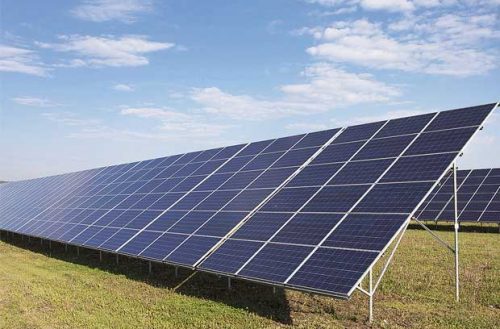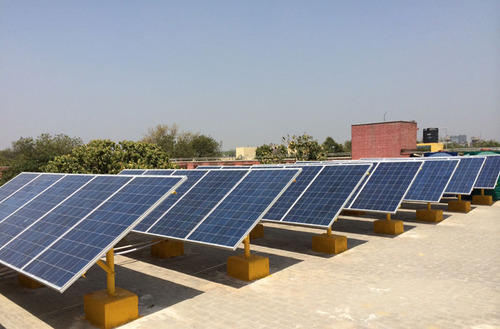Solar PV Power System
Solar Photo voltaic (PV) systems convert sunlight directly into electricity. A residential or commercial PV power system enables a home or business owner to generate some or all of their daily electrical energy demand on their own roof, exchanging daytime excess power for future energy needs (i.e. nighttime usage). The house remains connected to the electric utility at all times, so any power needed above what the solar system can produce is simply drawn from the utility. PV systems can also include battery backup or uninterruptible power supply (UPS) capability to operate selected circuits in the residence for hours or days during a utility outage. We undertake the turnkey solar projects (planning, designing, supply, installation and maintenance) ranges from Kilo Watt to Mega Watt.
Benefits of a solar PV power system
- Solar PV systems generate electricity
- Once the system has been purchased, electricity is generated from a ‘free’ resource—the sun
- Solar electricity is generated without emitting greenhouse gases
- Solar panels or modules are silent, without any moving parts
- Solar modules are generally unobtrusively mounted on an existing roof
- Solar modules can be integrated into the building in the form of windows, walls, roof tiles or pergola.
- Solar electricity can supplement or provide all your electrical consumption.
- Solar electricity can be fed into the grid.
- Additional solar modules can be added later as demand or budget grows.
- A solar module should last for at least 20–25 years.

Types of Solar Photovoltaic Power System
Major categories of Solar PV power plant designs Includes
1. Grid Connected Solar Power Plant(Ground Mounted & Roof Top )
2. Grid Interactive Solar Power Plant
3. Off Grid Solar Power Plant
4. Hybrid Solar Power Plant
5. Net Metering type Solar Power Plant
1. Grid Connected Solar Power Plant
Grid connected solar power plants are of two types. They are
(I) Ground Mounted Solar Power Plant
In a ground mounted solar power plant, the solar panels are installed on the ground and total generated power will be export to grid. The main components of ground mounted solar power plant as listed below:
• Solar PV Modules
• Central inverters
• String boxes
• Module mounting structure
• Cable & connectors
(II) Roof Top Solar Power Plant
In a rooftop solar power plant, the solar panels are installed in
the roof of any residential, commercial, institutional and industrial buildings.
This can be of two types
(1) Solar Rooftop power plant with storage facility using battery-The solar electricity is stored in the battery and can be utilized during night also when the sun is not available.
(2) Grid Connected Solar Rooftop System- the DC power generated from SPV panel is converted to AC power using power conditioning unit and is fed to the grid. These systems generate power during the day time which is utilized fully by powering captive loads and feed excess power to the grid as long as grid is available. In case, where solar power is not sufficient due to cloud cover etc., the captive loads are served by drawing power from the grid.
2. Grid Interactive Solar Power Plant
Grid Interactive solar power plants are of two types. They are
(I) Grid-Interactive with no Battery Backup
The major elements of a grid-connected PV system that does not include storage elements (Batteries) are shown in figure. A building has two parallel power supplies, one from the solar PV system and the other from the power grid. The combined power supply feeds all the loads connected to the main ACDB.
The ratio of solar PV supply to power grid supply varies, depending on the size of the solar PV system. Whenever the solar PV supply exceeds the building’s demand, excess electricity will be exported into the grid. When there is no sunlight to generate PV electricity at night, the power grid will supply all of the building’s demand.
A grid-connected system can be an effective way to reduce your dependence on utility power, greatest amount of bill savings to the customer per rupee of investment, increase renewable energy production, and improve the environment.
(II) Grid-Interactive With Battery Backup
This type of system incorporates energy storage in the form of a battery to keep “critical load” circuits in the house operating during a utility outage. When an outage occurs the unit disconnects from the utility and powers specific circuits in the home. These critical load circuits are wired from a subpanel that is separate from the rest of the electrical circuits. If the outage occurs during daylight hours, the PV array is able to assist the battery in supplying the house loads.
If the outage occurs at night, the battery supplies the load. The amount of time critical loads can operate depends on the amount of power they consume and the energy stored in the battery system.
3. Off-grid Solar PV System
Off-grid solar PV systems are applicable for areas without power grid. Currently, such solar PV systems are usually installed at isolated sites where the power grid is far away, such as rural areas or off-shore islands. But they may also be installed within the city in situations where it is inconvenient or too costly to tap electricity from the power grid.
An off-grid solar PV system needs deep cycle rechargeable batteries such as lead-acid, nickel-cadmium or lithium-ion batteries to store electricity for use under conditions where there is little or no output from the solar PV system, such as during the night.
4. Hybrid Solar Power Plant
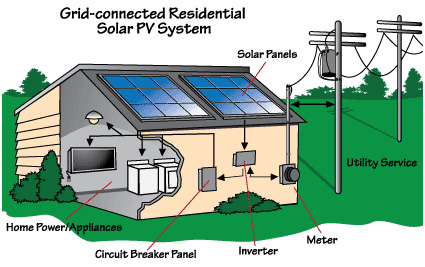
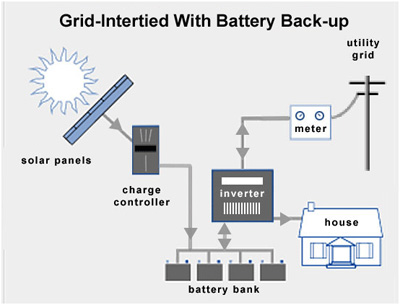

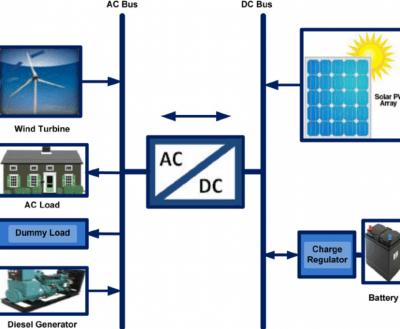
5. Net Metering Type Solar Power Plant
In grid-tied photovoltaic (PV) solar systems, In this case when your solar panels produce electricity, it goes first to powering the load (lights, appliances and electronics) in your home.
If your solar power system produces less electricity than you need or if you need energy when the sun isn’t shining at all during the night or cloudy weather, that power is automatically supplied from the utility grid.
If your solar power system produces more electricity than you need, the extra electricity can be either stored in the batteries (if available) or sold back to the utility grid. This difference of energy can be tracked using a meter connected to your solar PV system.
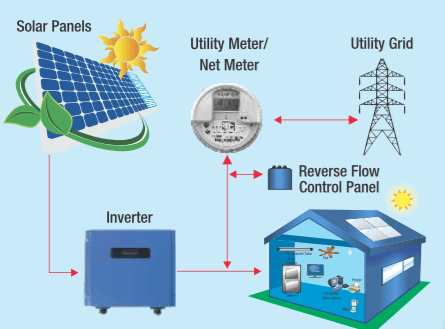
There are two types of meters
- Gross Metering
- Net Metering
Gross Metering: In gross metering, entire energy generated by solar PV system is fed back directly into the utility grid. In this case the owner gets incentives based on feed in tariffs propositional to the energy feedback to the grid.
Net Metering: Net metering is the difference of excess energy feedback into grid and total energy consumed from the grid by the system owner. It is an arrangement that allows a solar PV system owner to sell excess solar energy to the utility company or buy deficit energy from the utility company using a meter to track this energy exchange.
Applications
Solar Photo voltaic power can be used in a wide range of applications such as
HOMES
INDUSTRIES
AGRICULTURE
HOTELS
SCHOOLS
HOSPITALS
DAIRIES
AIRPORTS
ORGANIZATIONS
HOSTELS

